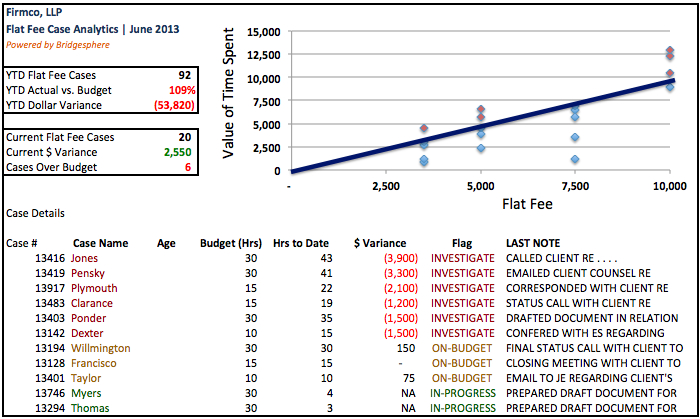Flat fees are just one of a multitude of alternative fee arrangements being offered by law firms in an effort to fuel growth, enhance differentiation, and provide clients with a degree of economic certainty. Unfortunately, some firms fail to consider whether flat fees improve law firm economics.
In this article, we offer law firm management some quick guidance on flat fees:
- Are they right for your law firm?
- How can you determine if flat fees improve law firm economics and profits per partner
Are flat fees right for your law firm?
There are two primary rationales for offering flat fee arrangements:
- Flat fees allow your law firm to capture market share in a segment where your hourly billing structures are otherwise uncompetitive.
- Flat fees (either directly or indirectly) improve profits per partner
We see certain law firms offering flat fee arrangements due to heightened price competition amongst their competitors. Just because a competitor is offering a flat fee structure, doesn’t mean you should. Flat fees should only be offered if it makes sense to capture market share that has strategic value to your law firm.
How to determine if it makes sense to capture share in a flat-fee market:
- Does your firm strategically benefit from the flat-fee market?
- Does offering a flat fee structure expose your firm to a desirable set of clientele that you have been unable to penetrate using traditional fee arrangements?
Strategic benefits are predominately marketing-related. Offering flat fees can give your firm an additional platform to promote its portfolio of services (not all of which are offered on a flat fee basis). Flat fees can communicate to your clients that your law firm is efficient, forward thinking, and conscious of the budgetary constraints of its clients.
Moreover, segmenting a portion of your law practice to flat fees can clearly delineate your pricing and marketing strategy between low-value services (the flat fees) and high-value services (which are priced at an hourly rate).
Exposure to a desirable set of previously unattainable clients is another possible benefit. If certain flat fee matters serve as an entry point for clients that ultimately procure some of your firm’s more profitable services, then flat fees can make good business sense. Flat fee entry points for high calibre law firms can lead to a segment of clients that otherwise would have bypassed your firm on price.
Three things need to happen for this to occur:
- Establish a highly-segmented, differentiated marketing platform for your flat fee services
- Be up-front on exactly what your flat fees entail
- Clearly communicate your pricing structure on more complex matters
Flat fees & law firm economics
If your law firm determines that flat fees make strategic sense, the next step is to determine whether flat fees will improve profits per partner.
If your law firm cannot clearly identify the strategic benefit of flat fees (as measured by market share or exposure to a new set of clients) – then you probably shouldn’t be offering them. They are unlikely to improve law firm economics or profits per partner. Chasing flat-fee clients places focus on one thing: revenues. Flat fees will likely result in chasing revenues with little regard to the costs associated with generating those revenues.
We observe this a lot. Chasing flat fees can quickly result in your associates selling and servicing flat fee clients when the firm would be more profitable doing less work under traditional fee arrangements. When this happens, profits per partner are dramatically lower than they would be had the law firm never offered flat fees in the first place.
Don’t leave a material portion of your partner compensation “on the table”. Carefully determine whether flat fees make strategic sense for your law firm, then determine whether flat fee structures will improve law firm economics and profits per partner.
Will flat fee arrangements improve profits per partner?
If it makes strategic sense to capture market share using flat fees, the next step is to determine whether flat fee structures will improve profits per partner. To accomplish this, we find it useful to isolate two things:
- The direct financial impact to PPP as a result of doing flat fee work
- The indirect impact to PPP (as measured by the additional profits generated by clients who initially engage the law firm on a flat-fee matter)
Determining the PPP impact of flat-fee matters involves a thorough examination of your law firm’s financial history. Using your historical accounting records, billing data, and collections history will reveal whether flat-fees have been accretive to profits per partner. Below is a high-level summary of the key data points to consider when measuring whether flat fees are improving law firm economics and profits per partner.

What if limited history is available? Then it is imperative that you spend time running high quality financial and practice management forecasts in an effort to determine if flat fees will improve profits per partner. These forecasts should define:
- Minimum number of flat fee cases that are economically acceptable
- Average price per client
- Average cost to service each matter
- % of flat fee clients that engage your firm for additional services
- Net realization rate of additional services
- Profits per partner (including and excluding) flat fee structures
Keeping flat fees accretive to law firm economics
Once your law firm has established that it makes strategic and financial sense to service a flat fee market, the next step is to monitor business performance – insuring that flat fee matters are meeting your financial goals and are accretive to profits per partner.
Business intelligence and performance measurement are sometimes overlooked in the realm of law firm management. While a quality business intelligence solution will insure that your law firm is meeting (or exceeding) its weekly and monthly financial goals, we will strictly focus on what management needs to review in the realm of flat fees.
Flat Fee Analytics: Improving profits per partner
In addition to running management’s weekly analysis of associate and partner productivity, law firm liquidity, and other relevant business performance metrics, careful attention should be devoted to flat fee matters. In its most simplistic state, this analysis needs to identify whether the firm has obtained an adequate volume of flat fee clients, the current and projected profitability of each engagement, and whether the current portfolio of flat fee cases was appropriately priced.
A successful analytics strategy should provide law firm management with a single report that allows them to effectively monitor a portfolio of flat fee matters in less than 30min. As seen from the chart below, these thirty minutes can improve profits per partner by tens of thousands of dollars per month when flat fee matters are getting “out of control”.

Flat fee engagements can improve law firm economics
Flat fee engagements can make good business sense, provided they are consistent with your law firm’s strategic plan and enable your firm to reach a previously unattainable set of desirable clients. Moreover, your flat fee clients should enhance profits per partner, either directly or indirectly. Monitoring the financial performance of your current portfolio of flat fee clients will insure that your initial decision continues to make money and improve law firm economics.
Boost profit & growth with Business Performance Planning
Click to learn more!
Law Firm Consulting
Click here to learn more about law firm consulting & read a collection of our recent case studies

Own it.
Whenever someone says they want to “manage” something, I cringe.
I immediately ask myself, is there a better word? After all, words matter. The words we chose carry deep significance, not just because of their inherent meaning, but because they give insight into our actions. They cast light on our motivations.
So when people tell me they’re going to manage something (or even worse, manage-through something), I immediately try and discern whether they’re setting themselves up for failure.
After all, ownership breeds success. Management reeks of passivity.
read more
Why you can’t lose those 10 pounds – And why Oprah should run for President
Americans are obsessed with weight loss.
Our culture is fixated on it. Everywhere you turn you see diet books, commercials for weight loss products. There are entire television series devoted to it. It seems like everyone at Trader Joe’s is infatuated with kale.
Even Weight Watchers can’t seem to go wrong. Call it the Oprah effect.
read more
What’s your legacy?
Because in the end, that’s all that really matters . . .
read more
The Hottest Thing on Tidal Since Beyoncé
Walking along Ocean Beach, I couldn’t help but gaze at the jaw dropping distance between where surf hit the sand and the waterline marking high tide from the night before.
A mere nine hours earlier, waves were crashing at a distance that would take a full 90 seconds to walk. To think that the gravitational pull of the moon and the sun are entirely responsible for these changes is astounding.
read moreLaw Firm Consulting
Click here to learn more about law firm consulting & read a collection of our recent case studies

